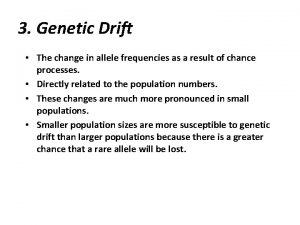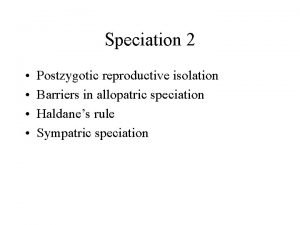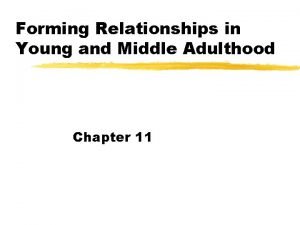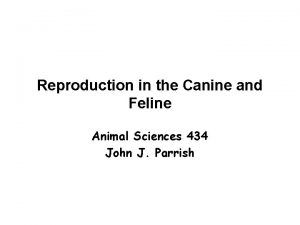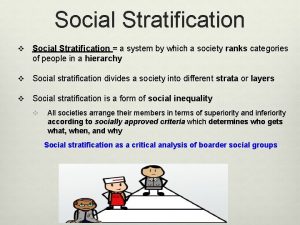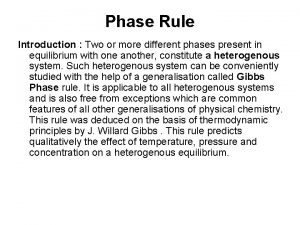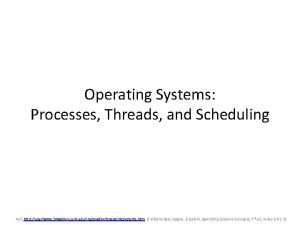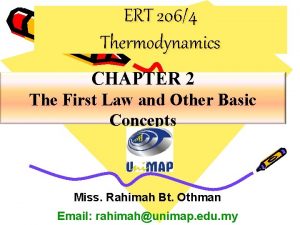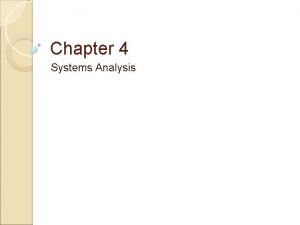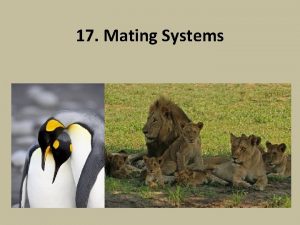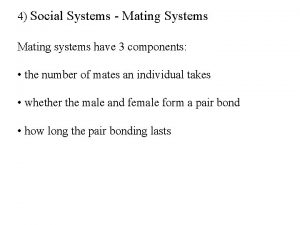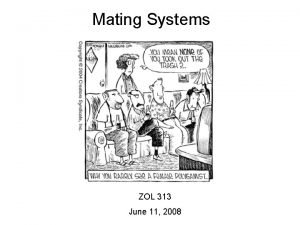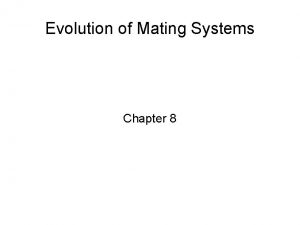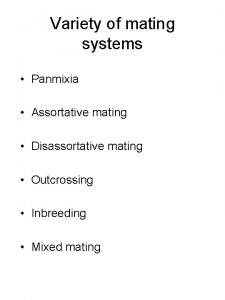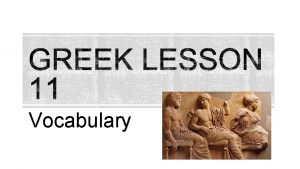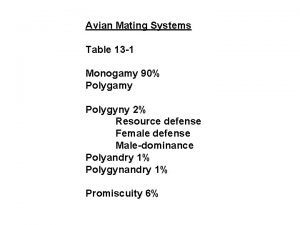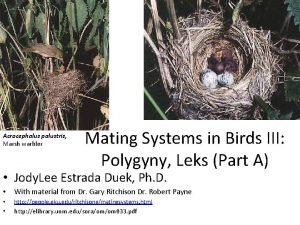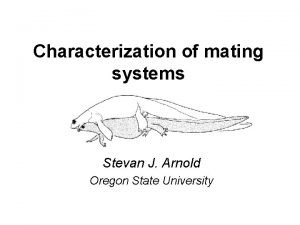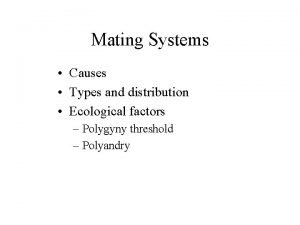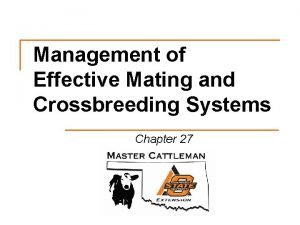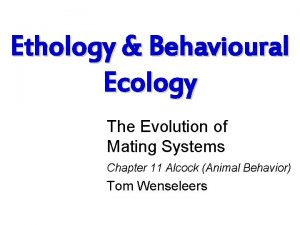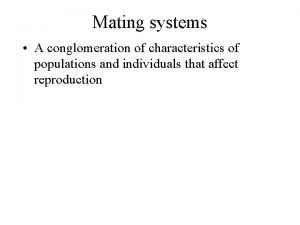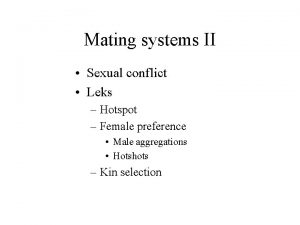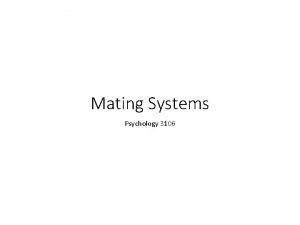Mating systems 1 Monogamous mating system 2 Polygamous

























































- Slides: 57


交配體系 (Mating systems) 交配體系的類型 1. Monogamous mating system 2. Polygamous mating system 2 a. Polygyny 2 b. Polyandry 3. Polygynandry (Promiscuous mating system) polygynous mating systems的生態與演化 Multiple mating systems in a single population? 2 Ayo 2011 Ethology 通識

3 Ayo 2011 Ethology 通識

1. Monogamous mating system Monogamy was rare in mammals, but it was much more common in smaller diurnal groups, particularly rodents. 範例:the oldfield mouse • Excavated more than 500 oldfield mouse burrows, captured the individuals in each burrow, and then brought them into the laboratory. • 90% of the offspring found in a family group were fathered by the male in their burrow 4 Ayo 2011 Ethology 通識

5 Ayo 2011 Ethology 通識

6 Ayo 2011 Ethology 通識

Monogamy and fitness consequences Choosing a high-quality mate, a mate that would give their partners high relative reproductive success by siring attractive offspring, offspring with strong immune systems, and so on. Significantly more pups were born to pairs made up of a male and his preferred mate 7 Ayo 2011 Ethology 通識

Proximate underpinnings of monogamy Prairie voles, dopamine, nucleus accubens (brain), linked affiliate (friendly) and aggressive behavior • two dopamine-related receptors (labeled D 1 and D 2) • When D 2 receptors were activated by dopamine, pair bonding was facilitated, • whereas when D 1 were activated by dopamine, pair bonding was inhibited. 8 Ayo 2011 Ethology 通識

Polygamous mating systems Polygyny – males mate with more than one female per breeding season Polyandry – females mate with more than one male per breeding season. 9 Ayo 2011 Ethology 通識

2 a. Polygyny 10 one well-studied form of polygyny is called lekking, or arena mating. • Lekking, which has been studied in birds, mammals, amphibians, fish, and insects, occurs when males set up and defend small arenas called leks – temporary territories specifically for mating– that typically contain no apparent resources (no food or shelter, for example). Ayo 2011 Ethology 通識

2 a. Polygyny Two questions: 1. What benefits do females obtain from this form of polygyny? 2. What benefits do males obtain? 兩個假說: • Good genes with respect to health • Sexy-son hypothesis 11 Ayo 2011 Ethology 通識

The benefits that females may receive 案例: Males defend small arenas that measure about 4 cm in diameter. • Females can choose freely among courting males, who emit a chemical attractant called a pheromone. 12 Ayo 2011 Ethology 通識

Good genes vs. sexy-son hypotheses Compared the survival of offspring that were the product of females that could choose among a random sample of males (part 1) and the offspring of females that were forced to choose between less attractive males (part 2). • No evidence for the good genes model was uncovered. Support the sexy-son hypothesis • When male offspring from part 1 and part 2 were placed in a lek, females showed a strong mating preference for the former. 13 Ayo 2011 Ethology 通識

polygyny in warblers Family of birds known as Acrocephaline warblers. Three known facts 1. Mating system vary from monogamous to polygynous 2. Warblers in monogamous systems show much higher levels of parental care than do warblers in polygynous systems, with monogamous males providing much more food to chicks than do polygynous males. 3. Warbler species in ranging from poor habitats with little food, to much better habitats that contain significantly more and better food types. 14 Ayo 2011 Ethology 通識

(A)The polygynous great reed warbler (B)The monogamous Seychelle warbler 15 Ayo 2011 Ethology 通識

polygyny in warblers A strong correlation between mating system and habitat quality • Most monogamous systems were found in poor habitats, and most polygynous systems were found in better habitats. 16 Ayo 2011 Ethology 通識

Where there was less food, there was greater paternal care; where there was more food, there was less paternal care. 17 Ayo 2011 Ethology 通識

2 b. Polyandry 18 Jacanas (水雉), a group of sex-role-reversed shorebirds, in which the males incubated the eggs and care for the young, and the females compete aggressively for multiple mates. Ayo 2011 Ethology 通識

Sex role reversal in northern jacanas Females defend a territory overlapping several male territories • She plays a dominant role in courtship • Females are much larger than males Females back up males in confronting potential predators • She’s more effective than the male at predator deterrence 19 Ayo 教材 (動物行為學 2010)

African jacana Males: build nests, incubate eggs, and care for and defend chicks. 20 Ayo 教材 (動物行為學 2010)

Polyandry in social insects 21 Polyandry has been well-studied in social insects, where a single queen will often mate with many worker males. Ayo 2011 Ethology 通識

Promiscuous mating systems When polyandry and polygyny are occurring in the same population of animals, the breeding system is said to be promiscuous. 案例:Barbary macaque(巴巴利獼猴) • During their estrous period, female Barbary macaques search for new male mating partners after each copulation. • Female will mate different males. • Male having numerous female sexual partners. 22 Ayo 2011 Ethology 通識

polygynandry Several males form pair bonds with several females simultaneously. 案例: dunnock (Prunella modularis) One or two males were resident on a female’s territory. • The more help a polygynandrous female received, the higher the mean nestling weight of the chicks in the brood and the lower the chick mortality rate due to starvation. 23 Ayo 2011 Ethology 通識

(A) A female with a newly hatched offspring. (B) A female feeding her brood. 24 Ayo 2011 Ethology 通識

Female territories are shown in green, while alpha male territories are depicted by solid red lines and beta male territories are shown by dashed red lines. We can find mating systems ranging from monogamy to polygamy, polyandry, and polygynandry. 25 Ayo 2011 Ethology 通識

polygynous mating systems 的生態與演化 Polygyny and resources The polygyny threshold model (PTM) • How the PTM works • The PTM and mate choice in female birds • The PTM and human female mate choice 26 Extrapair copulations Sperm competition Ayo 2011 Ethology 通識

Polygyny and resources A female can often fertilize all her available eggs by mating with one or a very few males. Females track resources • Female fecundity is not so much tied to the availability of mates as it is to the availability of resources, for example, food, defense, and so forth. Males track females • Males, on the other hand, can potentially fertilize large numbers of females, and so male reproductive success is more tightly associated with access to females than with access to resources. 27 Ayo 2011 Ethology 通識

Distribution of resources If resource are clumped, • males may be able to mate with and defend several females at once. • Females live together for easier access to resources and for protection from predators. 28 Ayo 2011 Ethology 通識

The polygyny threshold model (PTM) Imagine that ten males each have their own territory, and that these territories vary with respect to some resource that is valuable to females. • Male 1’s territory representing the area with the most food and male 10’s territory that with the least food. • The first female arriving to choose a male … • The second female choosing. . 案例:lark buntings 29 Ayo 2011 Ethology 通識

30 Ayo 2011 Ethology 通識

The PTM and human female mate choice 31 Kipsigi tribe of Kenya The number of wives was strongly affected by the size of his territory– with larger, and presumably more resourcerich, territories came an increase in the number of wives. Ayo 2011 Ethology 通識

In the Kipsigi population, polygyny is the norm. Kipsigi “co-wives” both relax (A) and work (B) together. (C) a man with many wives will have numerous huts, grain stores, strips for maize, and so on. 32 Ayo 2011 Ethology 通識

33 Ayo 2011 Ethology 通識

Extrapair copulations 34 Males and females were leaving their territories during the mating season and mating with other individuals, usually those in nearby territories. (Extrapair copulations, EPCs) The increased reproductive success of males who leave territories and engage in EPCs is clear, as they can fertilize more females. • But why would a female be involved in EPCs? Ayo 2011 Ethology 通識

Females be involved in EPCs 1. Increase the probability that all their eggs are fertilized 2. Maximize genetic diversity in their offspring 3. Use EPCs to select males who have good genes 4. Increase the amount of direct benefits– food, protection, and so on– that they receive from male. 35 Ayo 2011 Ethology 通識

案例:Indigo buntings About 13% of all mating were EPCs. • Females generally resisted EPCs to a greater extent than mating with their nesting partner, with the females resisting EPCs in 34 out of 43 attempts, while only resisting mating with their pairmates in 72 out of 320 attempts. 36 Using electrophoretic comparisons, 257 young that were biopsided, 37 had genotypes that were not consistent with the genotype of one of their presumed parents. (about 13% EPCs) Ayo 2011 Ethology 通識

(A)A female indigo bunting (B)A male indigo bunting 37 Ayo 2011 Ethology 通識

Sperm competition In some promiscuous mating systems, males compete not only for access to mating opportunities with females, but directly for access to eggs. Sperm storage occurs in sperm storage tubules (SST) at the uterovaginal junction. • Females can store sperm from multiple males, setting the stage for sperm competition. • Only a small proportion of sperm makes it into the SST. 38 Ayo 2011 Ethology 通識

39 Ayo 2011 Ethology 通識

Sperm competition in dungflies 40 Dungflies use the droppings of large, often domestic, animals as their choice site for breeding. While in most insects, copulations often last a matter of seconds, in dungflies they can last on the order of thirty minutes or more. Ayo 2011 Ethology 通識

41 Ayo 2011 Ethology 通識

The last male precedence 42 The number of eggs that were fertilized by the last male to mate with a female was proportional to how long such a mating lasted. The longer the last mating, the greater the reproductive success of the male. Ayo 2011 Ethology 通識

43 Ayo 2011 Ethology 通識

Sperm competition in sea urchins It can also play an important role in species that do not have internal fertilization. Sperm’s swimming speed and fertilization success. • To fertilize the same number of eggs, males who produced slow-moving sperm needed to release up to 100 times more sperm than males who produced fast-moving sperm. 44 Ayo 2011 Ethology 通識

45 Ayo 2011 Ethology 通識

Sperm competition in sea urchins Sperm decrease their swimming speed with age. • (A) in sea urchins, older sperm swim slower, • (B) a greater quantity of such sperm is needed to achieve high fertilization rates. 46 As they aged, they were much less likely to fertilize an egg, even when they encountered one. Ayo 2011 Ethology 通識

47 Ayo 2011 Ethology 通識

48 Ayo 2011 Ethology 通識

Other effects of sperm competition Kamikaze sperm hypothesis • Natural selection might favor the production of some sperm types that are designed to kill other males’ sperm rather than fertilize eggs. 49 Variability in sperm morphology Ayo 2011 Ethology 通識

50 Ayo 2011 Ethology 通識

Sperm number in humans Sperm competition has effects o the number of sperm produced per ejaculate. • Data on the interval between copulations in a given pair of individuals, and assumed that the longer this interval, the greater the chances that a partner would have been unfaithful. • Obtained sperm samples from individuals the next time they copulated with their partner. • the number of sperm ejaculated during a copulation is a function of the time since a pair last copulated. 51 Ayo 2011 Ethology 通識

Sperm number in humans 52 When couples spent more time together, and hence the risk of extrapair copulations was low, sperm count was significantly lower than when couples spent less time together. Ayo 2011 Ethology 通識

53 Ayo 2011 Ethology 通識

Multiple mating systems in a single population? Dunnocks: the long-term persistence of monogamy, polygyny, polyandry, and polygynandry in the same population. Battle of the sexes • Fitness of males: polygyny > monogamy > polyandry • Fitness of females: polyandry, polygynandry > monogamy > polygyny Females appear to be winning this battle: • 75% of females and 68% of males observed were involved in either polyandrous or polygynandrous mating groups. 54 Ayo 2011 Ethology 通識

The battle of the sexes: territory size 55 Difference between monogamy and polygyny is a function of male territory size. Difference between polyandry and polygynandry was a function of female territory size. Ayo 2011 Ethology 通識

Supplementing the food on dunnock territories led to a decrease in female territory size but not male territory size. 56 Ayo 2011 Ethology 通識

問題與討論 Ayo NUTN website: http: //myweb. nutn. edu. tw/~hycheng/
 Safe sex
Safe sex A poly relationship
A poly relationship Non random mating
Non random mating Assortative mating
Assortative mating Assortative mating
Assortative mating Dog semen collection
Dog semen collection Decision support systems and intelligent systems
Decision support systems and intelligent systems Dicapine
Dicapine Embedded systems vs cyber physical systems
Embedded systems vs cyber physical systems Elegant systems
Elegant systems Open system closed system and isolated system
Open system closed system and isolated system Digestive system respiratory system and circulatory system
Digestive system respiratory system and circulatory system Systems and system models
Systems and system models Circulatory system interactions with other systems
Circulatory system interactions with other systems Circulatory system interactions with other systems
Circulatory system interactions with other systems Kelsey-hayes abs module diagram
Kelsey-hayes abs module diagram Architecture of distributed operating system
Architecture of distributed operating system System models in distributed systems
System models in distributed systems Sic programming examples
Sic programming examples Physical model in distributed system
Physical model in distributed system Caste system versus class system
Caste system versus class system Open system vs closed system
Open system vs closed system Parlimentary system
Parlimentary system Unitary form
Unitary form Ducts in female reproductive system
Ducts in female reproductive system Endocrine system and reproductive system
Endocrine system and reproductive system How respiratory system work with circulatory system
How respiratory system work with circulatory system Religion and conflict theory
Religion and conflict theory Nervous system and digestive system
Nervous system and digestive system Mathematical expression of gibbs phase rule
Mathematical expression of gibbs phase rule Endocrine system vs nervous system
Endocrine system vs nervous system Features of system analysis
Features of system analysis Fitness center class diagram for gym management system
Fitness center class diagram for gym management system Lymphatic system vs endocrine system
Lymphatic system vs endocrine system System architecture diagram for hospital management system
System architecture diagram for hospital management system File system modules in distributed system
File system modules in distributed system Dss vs expert system
Dss vs expert system Circulatory system and respiratory system work together
Circulatory system and respiratory system work together User.dat proceso de mantenimiento
User.dat proceso de mantenimiento Two pipe system of providing building drainage consists of
Two pipe system of providing building drainage consists of System security in system analysis and design
System security in system analysis and design Features of installment purchase system
Features of installment purchase system Amino acid-based hormones
Amino acid-based hormones Job order vs process costing
Job order vs process costing Adh function
Adh function An effective systems proposal report should
An effective systems proposal report should Buddy system operating system
Buddy system operating system Aligned system and unidirectional system
Aligned system and unidirectional system Feasibility in system analysis and design
Feasibility in system analysis and design Compare embedded system and real time system
Compare embedded system and real time system Unidirectional system of dimensioning
Unidirectional system of dimensioning Using system.collections.generic
Using system.collections.generic Hauled container system and stationary container system
Hauled container system and stationary container system Message passing system in distributed system
Message passing system in distributed system Thermodynamics chapter 2
Thermodynamics chapter 2 Ai dss
Ai dss Message passing system in distributed system
Message passing system in distributed system System analysis definition
System analysis definition


